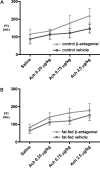Use of fat-fed rats to study the metabolic and vascular sequelae of obesity and beta-adrenergic antagonism
- PMID: 19619414
- PMCID: PMC2733295
Use of fat-fed rats to study the metabolic and vascular sequelae of obesity and beta-adrenergic antagonism
Abstract
Obesity-associated cardiovascular disease exerts profound human and monetary costs, creating a mounting need for cost-effective and relevant in vivo models of the complex metabolic and vascular interrelationships of obesity. Obesity is associated with endothelial dysfunction and inflammation. Free fatty acids (FFA), generated partly through beta-adrenergic receptor-mediated lipolysis, may impair endothelium-dependent vasodilation (EDV) by proinflammatory mechanisms. beta-Adrenergic antagonists protect against cardiovascular events by mechanisms not fully defined. We hypothesized that beta antagonists may exert beneficial effects, in part, by inhibiting lipolysis and reducing FFA. Further, we sought to evaluate the fat-fed rat as an in vivo model of obesity-induced inflammation and EDV. Control and fat-fed rats were given vehicle or beta antagonist for 28 d. Serum FFA were measured to determine the association to serum IL6, TNFalpha, and C-reactive protein and to femoral artery EDV. Compared with controls, fat-fed rats weighed more and had higher FFA, triglyceride, leptin, and insulin levels. Unexpectedly, in control and fat-fed rats, beta antagonism increased FFA, yet inflammatory cytokines were reduced and EDV was preserved. Therefore, reduction of FFA is unlikely to be the mechanism by which beta antagonists protect the endothelium. These results reflect the need for validation of ex vivo models of obesity-induced inflammation and endothelial dysfunction, concurrent with careful control of dietary fat composition and treatment duration.
Figures




Similar articles
-
Propranolol treatment lowers blood pressure, reduces vascular inflammatory markers and improves endothelial function in obese mice.Pharmacol Res. 2017 Aug;122:35-45. doi: 10.1016/j.phrs.2017.05.018. Epub 2017 May 21. Pharmacol Res. 2017. PMID: 28539257
-
A pathogenic role of visceral fat beta 3-adrenoceptors in obesity.J Clin Invest. 1995 Mar;95(3):1109-16. doi: 10.1172/JCI117758. J Clin Invest. 1995. PMID: 7883959 Free PMC article.
-
High FFA levels related to microalbuminuria and uncoupling of VEGF-NO axis in obese rats.Int Urol Nephrol. 2013 Aug;45(4):1197-207. doi: 10.1007/s11255-013-0428-9. Epub 2013 Apr 6. Int Urol Nephrol. 2013. PMID: 23563804
-
INFLUENCE OF OBESITY ON VASCULAR DYSFUNCTION AFTER TRAUMATIC HEMORRHAGE.Shock. 2023 Feb 1;59(2):318-325. doi: 10.1097/SHK.0000000000001991. Epub 2022 Oct 4. Shock. 2023. PMID: 36731028
-
Dahl salt-sensitive rats are protected against vascular defects related to diet-induced obesity.Hypertension. 2012 Aug;60(2):404-10. doi: 10.1161/HYPERTENSIONAHA.112.191551. Epub 2012 Jun 18. Hypertension. 2012. PMID: 22710645 Free PMC article.
References
-
- Abadie JM, Malcom GT, Porter JR, Svec F. 2001. Can associations between free fatty acid levels and metabolic parameters determine insulin resistance development in obese Zucker rats? Life Sci 69:2675–2683 - PubMed
-
- Acanfora D, Pinna GD, Gheorghiade M, Trojano L, Furgi G, Maestri R, Picone C, Iannuzzi GL, Marciano F, Rengo F. 2000. Effect of β blockade on the premature ventricular beats–heart rate relation and heart rate variability in patients with coronary heart disease and severe ventricular arrhythmias. Am J Ther 7:229–236 - PubMed
-
- Borst SE, Conover CF. 2005. High-fat diet induces increased tissue expression of TNFα. Life Sci 77:2156–2165 - PubMed
-
- Brehm BR, Bertsch D, von Fallois J, Wolf SC. 2000. β blockers of the third generation inhibit endothelin 1 liberation, mRNA production, and proliferation of human coronary smooth muscle and endothelial cells. J Cardiovasc Pharmacol 36:S401–S403 - PubMed
Publication types
MeSH terms
Substances
LinkOut - more resources
Full Text Sources
Medical
Research Materials
